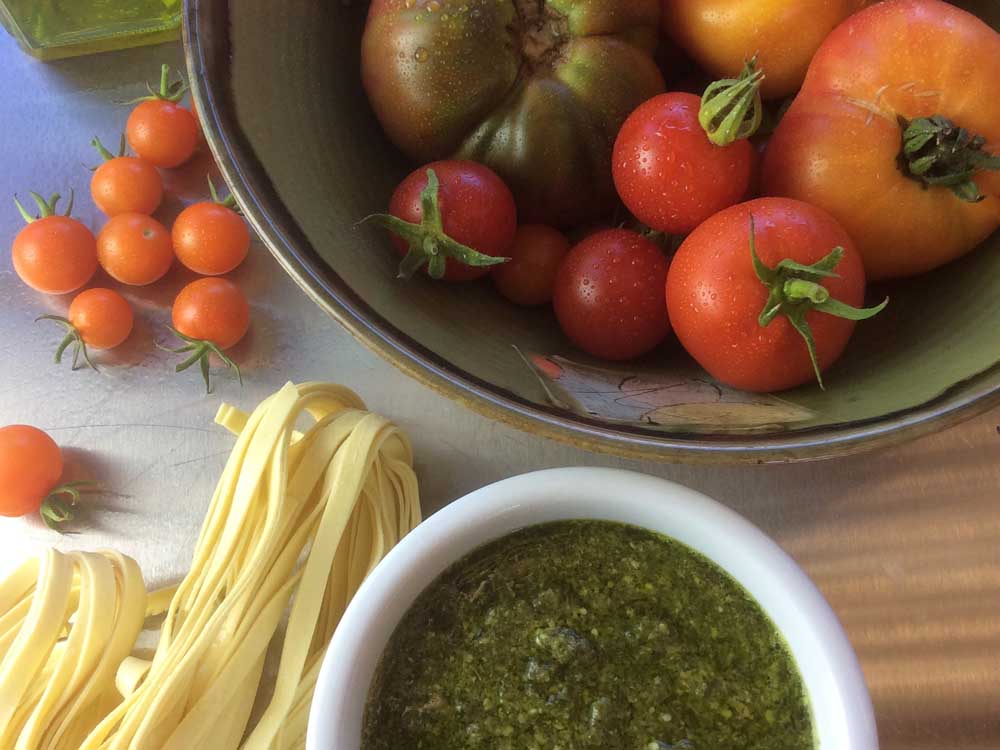Recipes: Pesto possibilities are endless
Published 12:00 am Tuesday, September 20, 2016

- Jan Roberts-Dominguez / For The BulletinWhile there’s still plenty of fresh basil and new-crop garlic, it’s time to make pesto. All those local, backyard tomatoes will taste even better with a dollop.
Central Oregon mornings might be getting too chilly to sustain a backyard crop of basil, but you can still count on local supplies from the Willamette Valley. Meanwhile, local garlic has been pulled moist and plump from the earth. Which in my book means I can ready up the blender. It’s time to make the pesto. That exquisite merging of basil, garlic, olive oil, cheese and pine nuts.
One of the season’s most treasured flavors, pesto brings goodness to so many of the foods I love: fresh pasta and salads, grilled chicken, hot and gooey panini, juicy tomatoes, roasted sweet onions and elegant bisques.
Trending
Storing your homemade pesto
For food-safety reasons, pesto should never be stored at room temperature. The U.S. Department of Agriculture says it can be safely stored in the refrigerator for three days, or indefinitely (until quality suffers) in the freezer.
Pack your homemade pesto into small containers. Cover with a thin layer of olive oil to cut down on discoloration, then cap tightly. Even so, the surface is most likely to darken during storage. This doesn’t affect the flavor. Simply stir the discolored pesto down into the brighter green pesto below.
I make several batches of this while basil is at its peak and freeze it in small quantities (1⁄2-cup or 1-cup containers), which, when thawed, can be used within a few days. I also freeze it by the heaping tablespoon on baking sheets covered with parchment or waxed paper. When the dollops of pesto are firm, place the chunks in a plastic bag and store in freezer.
Pesto enhanced
Perhaps you have a few tried-and-true ways you incorporate pesto into your meals. Here are some ideas:
Trending
• Flavored mayonnaise; 1 part pesto to 4 parts mayonnaise; use as a spread on sandwiches and crostini, salad topping or base for pasta salad.
• Delicious on a grilled sandwich of ham, prosciutto and cheese.
• With potatoes; baked, boiled or steamed; hot or cold potato salads.
• A flavoring for risotto.
• For a simple pasta dinner, saute a bit of onion in some olive oil then add 2 to 3 cups of diced tomatoes, a splash of dry white wine and/or chicken broth (you don’t need to peel the tomatoes if you cook them quickly) and cook until the tomatoes are heated through, then stir in a spoonful of pesto and toss the sauce with fresh-cooked hot pasta. Alternatively, pull apart some store-bought rotisserie chicken and add that to the pasta mixture.
• Halve sweet onions through their fattest part (you’ll also have to trim away a bit from the top and root ends). Place the halves in a baking dish, trimmed ends down, cut sides up; spread with a bit of pesto and bake, broil or grill until softened and the pesto is nice and bubbly.
• On pizza.
• With angel hair pasta; sometimes it’s all in the combination of ingredients. I just love angel hair pasta with pesto because there’s such a high ratio of pesto to pasta. Simply toss a generous amount of pesto with cooked and drained angel hair pasta, drizzle on a bit more olive oil if desired, plus several shakes of Parmesan, then toss again.
• Use as a final touch for soups.
• Use to enliven a traditional turkey sandwich or a chicken salad.
Safety first
Make some pesto and flavored oils for later … but keep it safe.
As long as I have pesto lurking in my freezer, I’m able to give my winter meals a dose of sunny-day flavor. It’s a concept the USDA supports. From a food-safety standpoint, freezing pesto is fine with food-safety experts there. On the other hand, storing pesto at room temperature or longer than three days in the refrigerator is something that makes them nervous. In fact, they plain and simply say, don’t do it. You could be courting botulism poisoning.
Certainly, it’s not a widespread problem. But the USDA stresses that once you’ve introduced moist, low-acid ingredients such as fresh basil or other fresh herbs and garlic to an unrefrigerated oil, the potential is there. The species of bacteria called clostridium botulinum thrives in such an environment as long as the temperature is within its comfort zone of 40 to 120 degrees.
Keeping things cool makes all the difference. So freezing is the perfect solution.
In light of all the elegant recipes that have spun off from the simple act of uniting a fine-quality oil with a fistful of fresh herbs and garlic, the USDA established some storage guidelines:
Pesto (puree of fresh basil, fresh garlic, pine nuts, olive oil, and Parmesan): Do not store at room temperature; can be safely refrigerated for a maximum of three days or frozen indefinitely (until quality suffers, which is usually within 12 to 18 months).
Flavored oils (oils containing fresh, low-acid ingredients such as fresh herbs, fresh garlic, or fresh chilies): Do not store at room temperature; can be safely refrigerated for a maximum of four days.
Infused oils (oils that are combined with low-acid foods such as fresh herbs, fresh garlic, or fresh chilies, and then strained to remove all of the solids): May be stored safely at room temperature indefinitely (until the oil turns rancid); quality keeps even longer when refrigerated.
— Jan Roberts-Dominguez is a Corvallis food writer, artist and author of “Oregon Hazelnut Country, the Food, the Drink, the Spirit” and four other cookbooks. Readers can contact her by email at janrd@proaxis.com, or obtain additional recipes and food tips on her blog at www.janrd.com.
(Editor’s note: This story has been corrected. The original version incorrectly stated the amount of time pesto and flavored oils can be stored in a refrigerator. The Bulletin regrets the error.)








